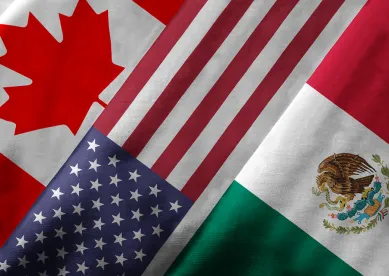A tripartite agreement to save NAFTA has been reached. The agreement, reached late last night, provides Congress the necessary 60 days’ notice of the text to approve so that President Pena Nieto of Mexico can sign before he leaves office on November 30th. All three countries wanted to get a deal done before the change of government in Mexico to President – Elect Lopez Obrador.
U.S. Trade Representative Robert Lighthizer and Canadian Foreign Affairs Minister Chrystia Freeland said the accord would be renamed the U.S.-Mexico-Canada Agreement (“USMCA”). The USMCA will replace the North American Free Trade Agreement, which dates to 1994 and covers $1.2 trillion in trade. The revised trade agreement addresses wide areas of the economy, ranging from patents and financial services to farming and auto manufacturing.
Key provisions of the agreement include:
-
The new automobile rule of origin requires 75% regional value content, up from 62.5%, and adds a required minimum percentage of labor cost at $16 per hour or higher for specified components.
-
The existing auto production capacities of Canada and Mexico will be excluded from Trump’s threatened Section 232 tariffs.
-
The Canadian market will gradually open to more exported American dairy products, including “fluid milk, cream, butter, skim milk powder, cheese and other dairy products.” Canada agreed to eliminate a program that helps Canadian sellers of certain milk products, at home and abroad.
-
The Investor State Dispute Resolution (ISDS) is significantly curtailed, with entities controlled by a non-market economy (i.e., Chinese owned Mexican entities) disqualified from using ISDS.
-
The steel and aluminum Section 232 tariffs remain in force for now. They will be separately negotiated, and Canada and Mexico hope to see them resolved before the agreement is signed in November.
-
There are new provisions to combat unfair trade practices in a number of areas, such as currency manipulation, state-owned enterprises and duty evasion. The currency provisions will be subject to dispute settlement.
-
The U.S. Administration says the USMCA contains stronger intellectual property provisions and environmental provisions than Trans Pacific Partnership, the agreement that President Trump withdrew from in his first days in office.
-
There will be a “sunset” provision requiring a “review” of the Agreement by the three parties every six years.
-
There will be 10 year data exclusivity for biologic drugs, which is what the U.S. and Mexico agreed to in August. Canada’s domestic data exclusivity for biologics has been eight years.
Things that didn’t change:
-
There is no significant change in the Chapter 19 AD/CVD dispute process or Chapter 20 state-to-state dispute process. The U.S. had previously sought to eliminate Chapter 19. The state-to-state dispute process is considered key to the enforcement of the stronger labor provisions that were accepted by Mexico.
-
Government procurement market access between the U.S. and Canada will continue to be governed by the WTO Government Procurement Agreement. Mexico is not a party to that agreement, but there are revisions in the USMCA to the prior NAFTA rules on U.S.-Mexico procurement market access.
The text has just been released, and the devil will, as always, be in the details.



 />i
/>i

